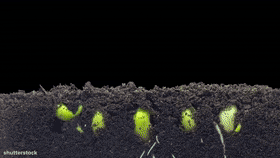Biofertilizer Scheme Gets Central Govt.’s Green Light
Context:
The PM-PRANAM (PM Programme for Restoration, Awareness, Generation, Nourishment and Amelioration of Mother Earth) initiative, which was promised in the previous budget, was authorised by the Cabinet Committee on Economic Affairs (CCEA) on Wednesday.
What is Cabinet Committee On Economic Affairs?
- Composition: The Prime Minister chairs the CCEA, which is made up of senior members of the Indian Cabinet. The committee also includes the ministers of commerce, agriculture, and finance as well as any other relevant ministers considered essential.
- Decision-making power: The CCEA has the power to decide on financial and economic issues that need high-level approval. Major investment plans, policy initiatives, and choices about economic growth are all reviewed and approved by it.
- Policy Formulation: The CCEA develops and shapes economic policy in several areas, including business, infrastructure, agriculture, energy, trade, and investment. To accomplish economic goals, it ensures coordination and consistency among many ministries and departments.
- Project approvals: The CCEA reviews and grants project approval for large investment initiatives with significant economic ramifications. Large-scale infrastructure initiatives, business expansions, bids for foreign direct investment, and strategic sector investments are a few examples of these undertakings.
- Pricing and subsidies: The CCEA discusses concerns over the cost of things including fertiliser, petroleum products, and other necessities. It establishes the subsidy levels and assesses the effects on the economy and welfare of the general public.
- Crisis management: The CCEA is essential in developing and putting into action plans to address the situation during economic emergencies or crises. To lessen the effect of the crisis on the economy, choices may need to be made regarding fiscal stimulus plans, assistance programmes, and policy actions.
- Making a report to the Cabinet: The Cabinet of India receives the CCEA’s decisions and recommendations for additional review and approval. The concerned ministries receive direction and directives from the Cabinet for efficient implementation.
What is PM-PRANAM?
-
- The PM PRANAM (Promotion of Alternate Nutrients for Agriculture Management Yojana) scheme was launched by the Indian government to reduce the use of chemical fertilizers and promote the balanced use of fertilizers in conjunction with biofertilizers and organic fertilizers. The objective of the scheme is to bring down the subsidy burden on chemical fertilizers, which was estimated to reach Rs 2.25 lakh crore in 2022-23, a 39% increase from the 2021 figure of Rs 1.62 lakh crore.
- Objectives:
A)Encourage the balanced application of fertilisers, including organic and biofertilizers.
B)lessen the financial burden of chemical fertiliser subsidies.
- Funding:
A)Savings from current fertiliser subsidies under programmes managed by the Department of Fertilisers will be used to pay for the programme.
B)There is no specific budgetary allocation for it.
- Grants to States:
A)The state that saves them money on subsidies will receive a grant in the amount of 50% of the savings.
B)States are encouraged by this to deliberately cut back on the use of chemical fertilisers.
- Asset Creation:
A)The scheme allows for the use of 70% of the grant money for asset creation.
B)This entails using alternative fertiliser technology and setting up production facilities at the village, block, and district levels.
C)The objective is to encourage the creation and application of alternative fertilisers.
- Incentives:
A)The grant’s remaining 30% can be used as an incentive to reward and motivate different stakeholders.
B)Incentives are available for farmers, panchayats, farmer-producer organisations, and self-help organisations that reduce fertiliser consumption and raise awareness.
C)This encourages people and organisations to actively engage in sustainable agriculture practices.
- Fertiliser Reduction Calculation:
A)The urea-specific reduction in chemical fertiliser consumption will be determined.
B)The amount of urea consumed in a given year will be contrasted with the average amount consumed over the previous three years.
C)For this, information from the Fertiliser Ministry’s Integrated Fertilisers Management System (IFMS) dashboard would be utilised.
- government’s burden of subsidy:
A)Maximum Retail Prices (MRP), which are discounts from market prices, are what farmers pay for fertilisers.
B) to bridge the difference between the MRP and the real production/import costs, the government offers subsidies to fertiliser firms.
C)The government wants to lessen the growing subsidy burden by implementing the PRANAM programme.
D)Fertilizer usage in India: India’s consumption of fertiliser totalled 1.62 trillion rupees in 2020–21, and is expected to reach 2.25 trillion in 2022.
E)The total amount of fertiliser needed—528.86 lakh metric tonnes in 2017–18 to 640.27 lakh metric tonnes in 2021–22—increased by 21%. This requirement included urea, DAP, MOP, and NPKS.
F)The requirement for DAP had the largest growth during this time, rising by 25.44 per cent.
G)The consumption of urea, the most popular chemical fertiliser, increased by 19.64% over the previous five years.
What did CCEA decide on the Biofertilizer scheme?
- Total Outlay: The scheme’s outlay is 3,70,128.7 crore in total.
- Participation of State Governments: State governments take part in the plan. By offering a subsidy from the savings from the decrease in the use of chemical fertilisers, the federal government will encourage states to embrace alternative fertilisers.
- Savings on Subsidies: If a State cuts back on the use of Conventional Fertilisers, the Savings on Subsidies will be based on the reduction. The subsidy savings, for instance, would be 3,000 crores if a state reduced its usage from a beginning usage of 10 lakh tonnes to three lakh tonnes.
- Central government Incentives: State adoption of alternative fertilisers will be rewarded by the federal government with 50% of the subsidy savings.
- Urea Subsidy Scheme to Continue: The CCEA approved the urea subsidy scheme to continue. This guarantees that farmers will continue to have access to urea at a set price of $242 for a bag weighing 45 kg.
- Promotion of Nano Urea: The country has seen a rise in the use of nano urea, a more effective and ecologically friendly form of urea. The government intends to put eight nano urea plants online by 2025–2026 with a 44 crore bottle output capacity.
- Market Development Assistance (MDA) for Organic Fertilizers: The CCEA authorised $1,451.84 crore for market development assistance (MDA) for organic fertilisers. With the help of this financing, organic fertilisers made from Gobardhan plants will be promoted.
- Organic Fertilizers Promotion: Fermented organic manures (FOM), liquid FOM, and phosphate-rich organic manures (PROM) produced as by-products from bio-gas plants or compressed biogas (CBG) plants established under the Gobardhan programme would be the main focus of the promotion for organic fertilisers.





